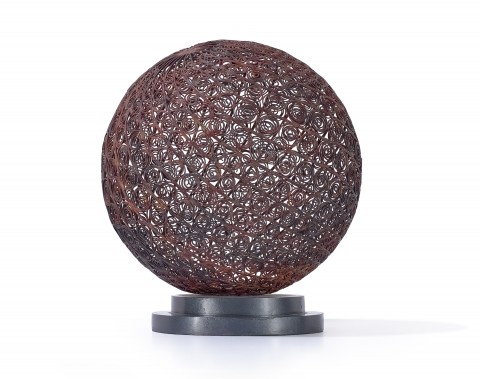LUNAR, 2001
BRONWYN OLIVER
copper on a wooden plinth
28.5 cm height
inscribed with title, date and artist's name at base: ‘Lunar’ 2001 / Bronwyn Oliver
Christine Abrahams Gallery, Melbourne
Private collection, Sydney
Deutscher and Hackett, Melbourne, 26 August 2009, lot 6
Private collection, Canberra
Bronwyn Oliver, Christine Abrahams Gallery, Melbourne, 24 November – 21 December 2001 (illus. on exhibition invitation)
Globe, 2002, copper, 300.0 cm diameter, in the collection of the University of New South Wales, Sydney
I think about sculpture as a kind of physical poetry, and I construct my sculpture like constructing sentences, in the sense that I try to exclude associations that are clouding the centre and leave in only associations that add meaning to the core.’1
As one of the country's leading and most celebrated sculptors, Bronwyn Oliver has left behind an important legacy. Her oeuvre presents perfectly resolved, organic sculptures predominantly in patinated copper and bronze. The highly skilled and painstaking craftsmanship involved in this process conveys the unbridled passion and commitment Oliver had for her practice.
There is an inherent transparency and softness to these resilient unyielding structures. Like veins in a leaf, an intricate system of copper is woven together to form an impeccable whole. Oliver was able to successfully tame this seemingly immutable medium, melding and stylising it to form a unique sculptural lexicon; unmatched and exclusively hers. Rhythmical waves, curves, wreaths, cylindrical spheres and cell-like structures mimic forms from the sea such as shells, amoeba, driftwood, tentacles, or braided seaweed not unlike the similar influence located in the architecture and interior design of Antoni Gaudí, inspired also by the aquamarine milieu.
Furthermore, there is an undeniable reference to astronomical and cosmic macro phenomena, to forms that inhabit the great ocean of outer space. Specifically in Lunar, 2001, hundreds of connected spiralling tendril-like coils are presented in a hollow globe labyrinth leaning off-centre from its axis, thereby alluding to galactical musings. The surface has a remarkable depth as demarcated by the ellipsoid shape. Captivating shadows are cast by Oliver's objects, such as Lunar, and are an integral part of the work. Intricate patterns become projected and warped as the interplay between light and form is enlivened.
This particular work is closely related to the major commissioned outdoor piece Globe, 2002, which is three metres in diameter and on permanent display at the University of New South Wales, Sydney.
Fragile yet robust, Oliver’s sculptures such as the present, are sophisticated, elegant and beautiful, embodying an incandescent clarity of vision. As Sebastian Smee recognises: 'As well as having a bold, classical symmetry, her sculptures have a private feeling about them, as of something freshly observed on a solitary walk.’2
1. The artist cited in Fenner, F., Bronwyn Oliver, Moet et Chandon, Epernay, France, 1995, n.p.
2. Smee, S., 'Nature of single-minded devotion', The Australian, 14 July 2006, p. 14
